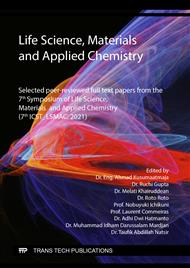[1]
J. Grein, N. Ohmagari, D. Shin, G. Diaz, E. Asperges, A. Castagna, T. Feldt, G. Green, M.L. Green, F.-X. Lescure, E. Nicastri, R. Oda, K. Yo, E. Quiros-Roldan, A. Studemeister, J. Redinski, S. Ahmed, J. Bernett, D. Chelliah, D. Chen, S. Chihara, S.H. Cohen, J. Cunningham, Monforte, A. D'Arminio, S. Ismail, H. Kato, G. Lapadula, E. L'Her, T. Maeno, S. Majumder, Massari, M.M. Mora-Rillo, Y. Mutoh, D. Nguyen, E. Verweij, A. Zoufaly, A.O. Osinusi, A. DeZure, Y. Zhao, L. Zhong, A. Chokkalingam, E. Elboudwarej, L. Telep, L. Timbs, I. Henne, S. Sellers, H. Cao, S.K. Tan, L. Winterbourne, P. Desai, R. Mera, A. Gaggar, R.P. Myers, D.M. Brainard, R. Childs, T. Flanigan, Compassionate use of remdesivir for patients with severe Covid-19, N. Engl. J. Med. 10 (2020) 1–10.
DOI: 10.1056/nejmoa2007016
Google Scholar
[2]
A. Cortegiani, G. Ingoglia, M. Ippolito, A. Giarratano, S. Einav, A systematic review on the efficacy and safety of chloroquine for the treatment of COVID-19, J. Crit. Care. 57 (2020) 279–283.
DOI: 10.1016/j.jcrc.2020.03.005
Google Scholar
[3]
O. Mitjà, B. Clotet, Use of antiviral drugs to reduce COVID-19 transmission, Lancet Glob. Health. 8 (2020) 639–640.
DOI: 10.1016/s2214-109x(20)30114-5
Google Scholar
[4]
J. Liu, R. Cao, M. Xu, X. Wang, H. Zhang, H. Hu, Y. Li, Z. Hu, W. Zhong, M. Wang, Hydroxychloroquine, a less toxic derivative of chloroquine, is effective in inhibiting SARS-CoV-2 infection in vitro, Cell Discov. 16 (2020) 6–9.
DOI: 10.1038/s41421-020-0156-0
Google Scholar
[5]
X. Yao, F. Ye, M. Zhang, C. Cui, B. Huang, P. Niu, X. Liu, L. Zhao, E. Dong, C. Song, S. Zhan, R. Lu, H. Li, W. Tan, D. Liu, In vitro antiviral activity and projection of optimized dosing design of hydroxychloroquine for the treatment of severe acute respiratory syndrome Coronavirus 2 (SARS-CoV-2), Clin. Infect. Dis. 71 (15) (2020) 732-739.
DOI: 10.1093/cid/ciaa237
Google Scholar
[6]
E. Sanganyado, Z. Lu, Q. Fu, D. Schlenk, J. Gan, Chiral pharmaceuticals : a review on their environmental occurrence and fate processes, Water Res. 124 (2017) 527–542.
DOI: 10.1016/j.watres.2017.08.003
Google Scholar
[7]
S.J. Ashwini, S.T. Narenderan, S.N. Meyyanathan, B. Babu, B. Gowramma, A validated chiral HPLC method for the enantiomeric separation of Mefloquine, Res. J. Pharm. Technol. 12 (5) (2019) 2304–2308.
DOI: 10.5958/0974-360x.2019.00384.6
Google Scholar
[8]
J. Tian, M. Pan, Y. Ma, J.W. Chew, Effect of membrane fouling on chiral separation, J. Membr. Sci. J. 593 (2020) 1–8.
Google Scholar
[9]
A. Tarafder, L. Miller, Chiral chromatography method screening strategies: past, present and future, J. Chromatogr. A. 1638 (2021).
DOI: 10.1016/j.chroma.2021.461878
Google Scholar
[10]
A. Garg, A. Tadesse, R. Eswaramoorthy, A four-component domino reaction : an eco-compatible and highly efficient construction of 1,8-naphthyridine derivatives, their in silico molecular docking, drug likeness, ADME, and toxicity studies, J. Chem. (2021).
DOI: 10.1155/2021/5589837
Google Scholar
[11]
V.G. Dongre, P.D. Ghugare, P. Karmuse, D. Singh, A. Jadhav, A. Kumar, Identification and characterization of process related impurities in chloroquine and hydroxychloroquine by LC/IT/MS, LC/TOF/MS and NMR, J. Pharm. Biomed. Anal. 49 (4) (2009) 873–879.
DOI: 10.1016/j.jpba.2009.01.013
Google Scholar
[12]
E. Yuanita, Sudirman, N.K.T. Dharmayani, M. Ulfa, J. Syahri, Quantitative structure–activity relationship (QSAR) and molecular docking of xanthone derivatives as anti-tuberculosis agents, J. Clin. Tuberc. Other Mycobact. Dis. 21 (2020).
DOI: 10.1016/j.jctube.2020.100203
Google Scholar
[13]
S. Shivanika, D. Kumar, V. Ragunathan, P. Tiwari, S. Sumitha, B. Devi, Molecular docking, validation, dynamics simulations, and pharmacokinetic prediction of natural compounds against the SARS-CoV-2 main-protease, J. Biomol. Struct. Dyn. 8 (2020) 1–27.
DOI: 10.1080/07391102.2020.1815584
Google Scholar
[14]
K. Terayama, M. Sumita, M. Katouda, K. Tsuda, Y. Okuno, Efficient search for energetically favorable molecular conformations against metastable states via gray-box optimization, J. Chem. Theory Comput. 17 (8) (2021) 5419–5427.
DOI: 10.1021/acs.jctc.1c00301
Google Scholar
[15]
M.S. Fallah, M. Bayati, A. Najafi, E. Behmard, S.J. Davarpanah, Molecular docking investigation of antiviral herbal compounds as potential inhibitors of SARS-CoV-2 spike receptor, Biointerface Res. Appl. Chem. 11 (2021) 12916–12924.
DOI: 10.33263/briac115.1291612924
Google Scholar
[16]
K. Nishi, T. Ono, T. Nakamura, N. Fukunaga, M. Izumi, H. Watanabe, A. Suenaga, T. Maruyama, Y. Yamagata, S. Curry, M. Otagiri, Structural insights into differences in drug-binding selectivity between two forms of human α1-acid glycoprotein genetic variants, the A and F1*S Forms*, J. Biol. Chem. 286 (2011) 14427–14434.
DOI: 10.1074/jbc.m110.208926
Google Scholar
[17]
O. Trott, A.J. Olson, AutoDock Vina: improving the speed and accuracy of docking with a new scoring function, efficient optimization and multithreading, J. Comput. Chem. 31 (2010) 455–461.
DOI: 10.1002/jcc.21334
Google Scholar
[18]
D.F. Kawano, B.Z. Costa, K.L. Romero-Orejón, H.C. Loureiro, D.P. de Jesus, A.J. Marsaioli, The enantiomeric discrimination of 5-hexyl-2-methyl-3,4-dihydro-2H-pyrrole by sulfobutyl ether-β-cyclodextrin: a case study, Molecules. 26 (2021) 1689–1699.
DOI: 10.3390/molecules26092611
Google Scholar
[19]
E.S. Nurhidayah, A.L. Ivansyah, M.A. Martoprawiro, M.A. Zulfikar, A molecular docking study to predict enantioseparation of some chiral carboxylic acid derivatives by methyl-β-cyclodextrin, J. Phys.: Conf. Ser. 1013 (2018).
DOI: 10.1088/1742-6596/1013/1/012203
Google Scholar



